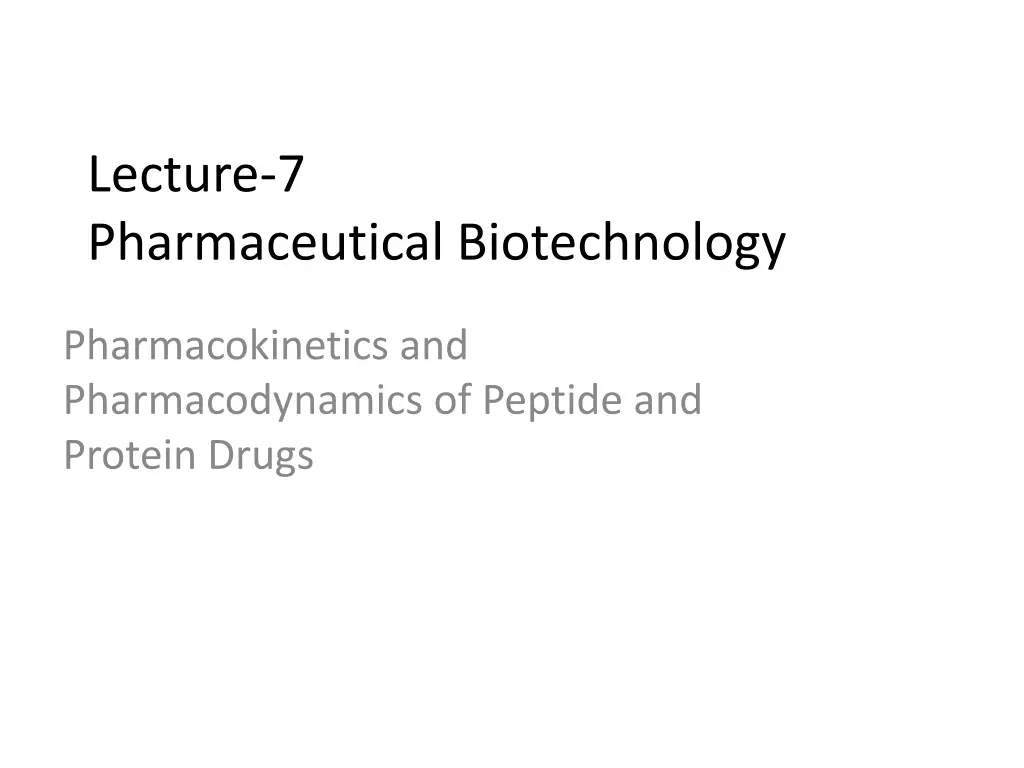
Understanding Pharmacokinetics and Pharmacodynamics of Peptide and Protein Drugs
Explore the crucial aspects of pharmacokinetics and pharmacodynamics in relation to peptide and protein drugs, including their absorption, distribution, metabolism, and more. Discover the specific challenges posed by these types of therapeutics and how they differ from traditional small molecule drugs.
Download Presentation

Please find below an Image/Link to download the presentation.
The content on the website is provided AS IS for your information and personal use only. It may not be sold, licensed, or shared on other websites without obtaining consent from the author. If you encounter any issues during the download, it is possible that the publisher has removed the file from their server.
You are allowed to download the files provided on this website for personal or commercial use, subject to the condition that they are used lawfully. All files are the property of their respective owners.
The content on the website is provided AS IS for your information and personal use only. It may not be sold, licensed, or shared on other websites without obtaining consent from the author.
E N D
Presentation Transcript
Lecture-7 Pharmaceutical Biotechnology Pharmacokinetics and Pharmacodynamics of Peptide and Protein Drugs
The central paradigm of clinical pharmacology: The dose-concentration-effect relationship Efficacy Dose concentration Toxicity pharmacokinetics Pharmacodynamic
Introduction Pharmacokinetics describes the time course of a drug in a body fluid, preferably plasma or blood, that results from the administration of a certain dosage regimen. It comprises all processes affecting drug absorption, distribution, metabolism, and excretion.
Simplified, pharmacokinetics characterizes what the body does to the drug. In contrast, pharmacodynamic characterizes the intensity of a drug effect or toxicity resulting from certain drug concentration in a body fluid, usually at the assumed site of drug action. It can be simplified to what the drug does to the body
Protein bound drug Tissue bound drug Drug Absorption Distribution Pharmacokinetics Plasma concentration Tissue concentration Elimination Drug bound to Receptor/ effector Metabolism Excretion Drug in effect compartment Pharmacodynamics Post-receptor events biochemical events Pharmacological response
General pharmacokinetic and pharmacodynamic principles are to a large extent equally applicable to protein and peptide drugs as they are to traditional small molecule-based therapeutics. Deviations from some of these principles and additional challenges with regard to the characterization of the pharmacokinetics and pharmacodynamics of peptide and protein therapeutics, however, arise from some of their specific properties:
a. Their structural similarity to endogenous structural proteins and nutrients. b. Their intimate involvement in physiologic processes on the molecular level, often including regulatory feedback mechanisms. c. The analytical challenges to identify and quantify them in the presence of a myriad of similar molecules d. Their large molecular weight and macromolecules character (for proteins).
Pharmacokinetics of protein therapeutics The in vivo disposition of peptide and protein drugs may often be predicted to a large degree from their physiological function. Peptides, for example, which frequently have hormone activity, usually have short elimination half-lives, which is desirable for a close regulation of their endogenous levels and thus function.
Insulin, for example shows dose-dependent elimination with a relatively short half-life of 25 and 52 minutes at 0.1 and 0.2 U/kg, respectively. Contrary to that, proteins that have transport tasks such as albumin or long-term immunity functions such as immunoglobulins have elimination half-lives of several days, which enables and ensures the continuous maintenance of physiologically necessary concentrations in the bloodstream.
Absorption of protein therapeutics Enteral Administration Peptides and proteins, unlike conventional small molecule drugs, are generally not therapeutically active upon oral administration. The lack of systemic bioavailability is mainly caused by two factors; (1) high gastrointestinal enzyme activity and (2) low permeability mucosa.
Thus, although various factors such as permeability, stability and gastrointestinal transit time can affect the rate and extent of absorption of orally administrated proteins, molecular size is generally considered the ultimate obstacle. Oral administration is still desired route of delivery for protein drugs due to 1. Its convenience 2. Cost-effectiveness and 3. painlessness
Strategies to overcome the obstacles associated with oral delivery of proteins Suggested approaches to increase the oral bioavailability of protein drugs include encapsulation into micro- or nanoparticles thereby protecting proteins from intestinal degradation. Other strategies are chemical modifications such as amino acid backbone modifications and chemical conjugations to improve the resistance to degradation and the permeability of protein drug. Coadministration of protease inhibitors has also been suggested for the inhibition of enzymatic degradation.
Parenteral Administration Most peptide and protein drugs are currently formulated as parenteral formulations because of their poor oral bioavailability. Major routes of administration include intravenous (IV), subcutaneous (SC), and intramuscular (IM) administration. In addition, other non-oral administration pathways are utilized, including nasal, buccal, rectal, vaginal, transdermal, ocular and pulmonary drug delivery.
IV administration of peptides and proteins offers the advantage of circumventing (avoiding) presystemic degradation, thereby achieving the highest concentration in the biologic system. IV administration as either a bolus dose or constant rate infusion, however, may not always provide the desired concentration-time profile depending on the biologic activity of the product. In this cases, IM or SC injections may be more appropriate.
For example, luteinizing hormone-releasing hormone (LH-RH) in bursts stimulates the release of follicle-stimulating hormone (FSH) and luteinizing hormone (LH), whereas a continuous baseline level will suppress the release of these hormones. To avoid the high peaks from an IV administration of leuprorelin, an LH-RH agonist, a long acting monthly depot injection of the drug is approved for the treatment of prostate cancer.
IV versus SC A recent study comparing SC versus IV administration of epoetin- in patients receiving hemodialysis reports that the SC route can maintain the homatocrit in a desired target range with a lower average weekly dose of epoetin- compared to IV. The hematocrit also known as packed cell volume (PCV) or erythrocyte volume fraction (EVF), is the volume percentage (%) of red blood cells in blood.
Limitation of SC and IM One of the potential limitation of SC and IM administration, however, are the presystemic degradation process frequently associated with these administration routes, resulting in a reduced bioavailability compared to IV administration. The pharmacokinetically derived apparent absorption rate constant kappfor protein drugs administrated via these administration routes is thus the combination of absorption into the systemic circulation and presystemic degradation at absorption site, i.e., the sum of a true first- order absorption rate constant kaand a first- order degradation rate constant.
The true absorption rate constant kacan then be calculated as Ka= F. Kapp Where f is the bioavailability compared to IV administration. A rapid apparent absorption, i.e., large kapp, can thus be the result of a slow true absorption and fast presystemic degradation, i.e., a low systemic bioavailability.
Other potential factors that may limit bioavailability of proteins after SC or IM administration include variable local blood flow, injection trauma, and limitation of uptake into systemic circulation related to effective capillary pore size and diffusion. Following an SC injection, peptide and protein therapeutics may enter the systemic circulation either via blood capillaries or through lymphatic vessels. In general, macromolecules larger than 16 kDa are predominantly absorbed into the lymphatics whereas those under 1 kDa are mostly absorbed into blood circulation.
There appears to be a linear relationship between the molecular weight of the protein and the proportion of the dose absorbed by the lymphatics (see Figure 2 in Lecture 5). This is of particular importance for those agents whose therapeutic targets are lymphoid cell (i.e., interferons and interleukins).






















